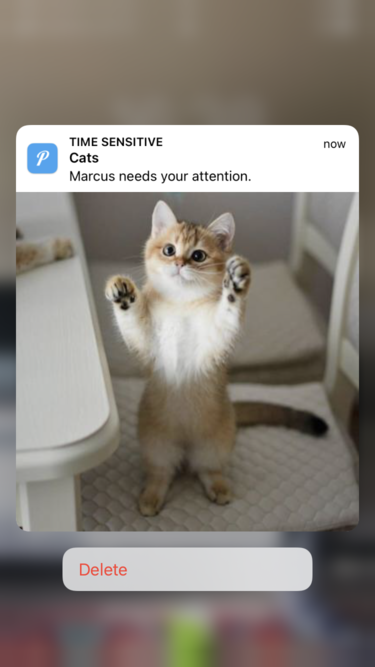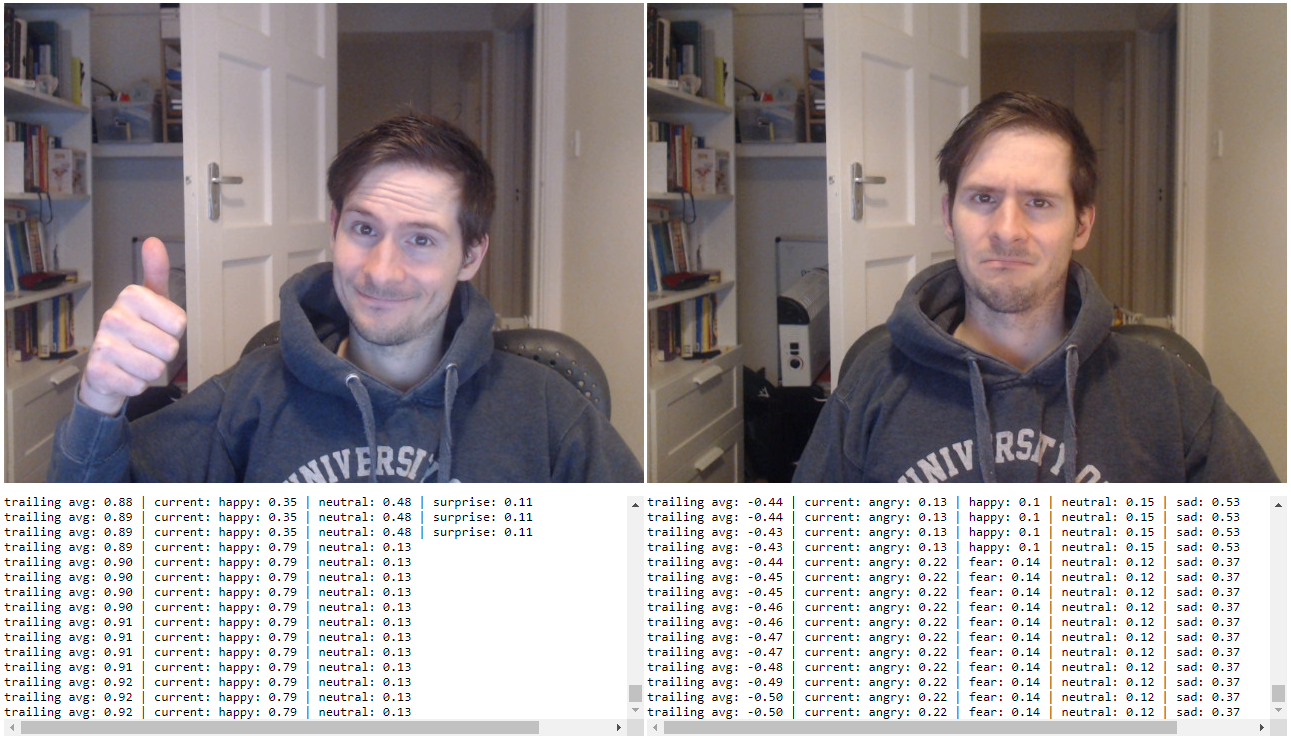I wrote a program that sends cats to my phone when I'm sad at the computer. I was inspired by a tweet I saw last week. I've lost the link but, to paraphrase, it went something like this:
I'm okay submitting myself to The Algorithm as long as it knows when I'm sad and forwards cats directly to my face
I figured that you could probably solve this problem locally without leaking any personal data.

Our computers are fast enough that we can run machine learning models in a browser in the background, maybe without even noticing. I tried out a few different JavaScript face recognition libraries that came prepackaged with trained models, and evaluated them by the following criteria:
- Is there example code I can easily hack on?
- Does it accurately reporting when I'm frowning, furrowing, or furious?
I went with vladmandic/human — another strong contender was justadudewhohacks/face-api.js. Both these libraries provide an API to get the weights of some common emotions.
['sad', 'angry', 'disgust', 'fear', 'neutral', 'happy', 'surprise']
I split the emotions into good vs. bad to get a clearer read of my mood. The overall score swings between -1 (very bad) and 1 (very good). I don't want to be spammed with cats every time I itch my nose and trigger a frame of video that's interpreted as negative so I added a three-second trailing average to look for prolonged periods of negative emotion. There's also a timeout of five minutes after sending a cat before it starts checking again.
You can see some of the emotion scores below in the debug console I added.

I wrote all the frontend code in an index.html file for the prototype. The main loop runs at 30-40FPS on a decade-old desktop (it reads emotion accurately at far lower FPS and should probably be capped to save resources).
function main() {const config = { backend: 'webgl' }const human = new Human.Human(config)async function detectVideo() {// `inputVideo` is a video of a webcam streamconst result = await human.detect(inputVideo)// `result` contains an array of faces along with emotion weightshandleResult(result)requestAnimationFrame(detectVideo)}detectVideo()}
The web server runs locally and serves this file and the model data. The full source code is on healeycodes/if-sad-send-cat.
Notifications
I used Pushover to send notifications to my iPhone. The API/docs and community libraries are delightful, and there's a one month free trial (no credit card required, etc). I had heard of programmers using Pushover as part of different home automation projects and was keen to try it out.
Here's how I send a message and an image from server.py:
r = requests.post("https://api.pushover.net/1/messages.json",data={"token": token,"user": user,"message": f"{cat_name} needs your attention.",},files={"attachment": (f"{cat_name}", open(cat_picture, "rb"), "image/jpeg")},)
You'd think that I would be most impressed by my computer being able to read the emotions from my face but I actually think Pushover is the coolest part of this project. The phrase "it just works" is over-used but I found Pushover to be the real deal. I'm going to use it to replace Slack/email/text alerts in my future projects.
The Cats
I glued together two APIs to get the message data. A random name comes from https://randomuser.me/api/ and a random cat image is downloaded from https://api.thecatapi.com/v1/images/search. I actually need to download and resize the images because The Cat API (Cats as a Service) seems committed to providing very high resolution felines (we're talking 5MB+). Which is how I ended up with this cutely-named function:
def shrink_cat(path):image = Image.open(path)image.thumbnail((400, 400))image.save(path)
I used Python's SimpleHTTPRequestHandler to serve my static files. This is the same server that runs when you serve files with the famous one-liner python -m http.server.
My plan was to have no backend running for this, and while that's still an achievable goal, I found it quicker to write the API glue code in Python. When I realised that I needed an API route to handle the "send cat" event I was about to install Flask when I realised I could just .. keep on using this simple server by adding this hack:
class HttpRequestHandler(http.server.SimpleHTTPRequestHandler):# future employers, please look away# while I override this functiondef translate_path(self, path):if path == "/web/cat.json":send_cat()return super().translate_path(path)
What's Your Plan With The Emotion Tracking?
My original idea was to track my emotions and which programming language I was currently editing. So I might work on that next.
Prepare yourself for a future blog post with one of the following empirical titles:
- I'm more surprised when I'm writing JavaScript instead of TypeScript
- Python Just Makes Me Happy
- YAML Makes Me Feel Fear